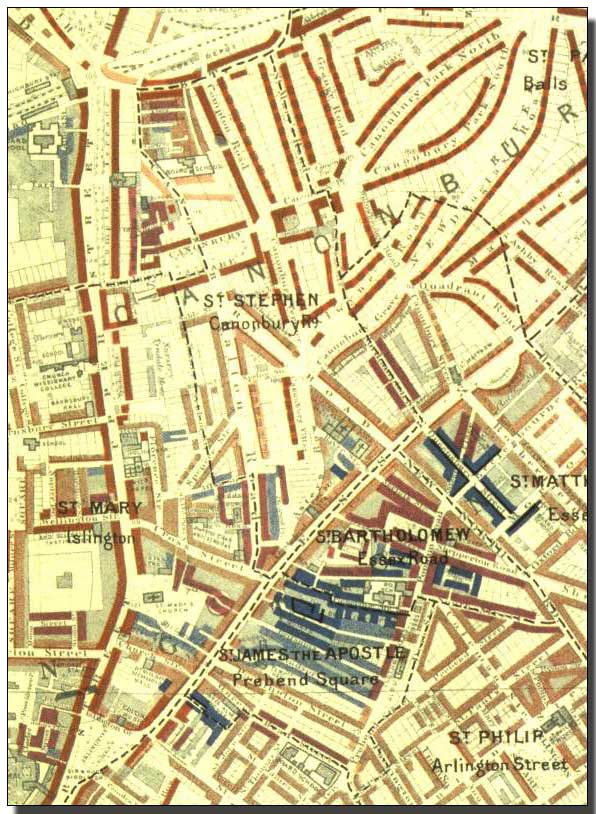By the 1870s Industry and a flood of new inhabitants had changed the situation in Islington completely. Muswell Hill was still far out in the country, but London was expanding and Islington had become overcrowded. The area had become delapidated as houses were split into floors and rooms. Industry established itself in outbuildings and basements. Some areas became slums.
In Booth's 1889 Map of Wealth and Poverty, he printed the streets of London in seven colours according to the incomes of the occupants. Yellow showed great wealth and Black extreme poverty, with dark blue and light blue only slightly better off. Upper Street, Islington, is marked with large areas of poverty. The site of the present Peabody Buildings, those monuments to the Victorian philanthropic drive, is marked in Black or Dark blue. This is where the London School Board was searching for a site.

Booth Map of Canonbury/Islington Green School
The Booth Maps extend only as far north as Stoke Newington so there are no Booth Maps of Muswell Hill, but for anyone interested in the Expansion of London they are a vital starting point.
Uses of the Booth Poverty Maps in this website.
------
The Search for the School Site Continued
Finally the Clothworkers' Guild offered a row of decrepit houses which were at the end of their leases, many used for small industry. The Clothworkers appear to have been good landlords and these houses sem to have given them some bulding troubles over the years, so perhaps they may have been glad to sell.
| 'The Masters, Wardens and Commonalty of Freemen of the Art or Mystery of Clothworkers of the City of London' sold the property which consisted of workshops, machine room, engine and boiler house, sheds, covered yards, yards, roadways and outbuildings in Rheidol Terrace and St James's Street. Two school buildings with highpitched roofs were erected in 1884, one of which is illustrated here. |
When the school was enlarged in 1892, the original Nursery School building was extended to cover much of the playground, making the free space even more restricted. In 1910 the London County Council (which had taken over from the London School Board) installed hot water radiators and built a boiler house below. Before this there had been no need for a boiler as each room had an open fire with its own chimney. Each day every fire had to be cleared out, ashes removed, the fire relaid and lit before the classes arrived. The smoke from all those chimneys produced pea-souper fogs, yellow, dense and choking.
It is rather sad that some modern children, brought up in centrally heated houses, have no idea what a chimney does. They draw houses in the traditional way - a square box with a door and windows, and a pitched roof with a chimney belching smoke. But in the children's minds there is nothing under the chimney. It does not connect to anything. The chimney is a sort of appendix to the house, a folk memory of an earlier functioning chimney as the human appendix is a relic of an earlier digestive system.
By reducing the number of fires in the school, pollution was slightly reduced, but not enough to counter TB. At the same time as the other building work, the LCC put on a flat roof surrounded by high walls and large wrought iron grilles, to form an open air Marching Space, in the hope of warding off illness. Exercise could be taken on the roof in all but rain. Cups and shields were awarded for competitive marching, but the real purpose was health.
The Chairman of the School Board for London said in 1884:-
| 'At the instance of the Chairman of the Works Committee, whose connection with measures for arresting disease in London is well known, special attention has been paid to the sanitary condition of our schools, and it may be safely said that this is now as well considered and as complete as in a first rate hospital. At a time when dangerous epidemics threaten the metropolis, I feel this will be a satisfaction to the public mind. In some of our schools considerations of expense and contracted sites have compelled us to provide playgrounds on the roof. It is worthy of note that the winning school in the drill competition this year was confined to an airy but confined space of this kind.' |
227
